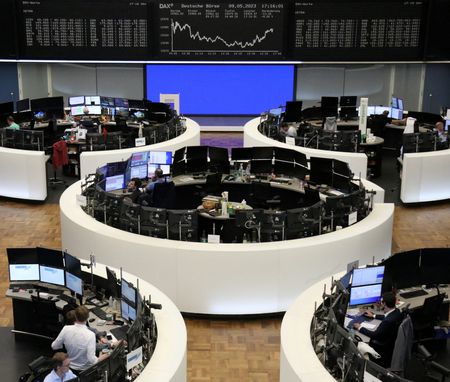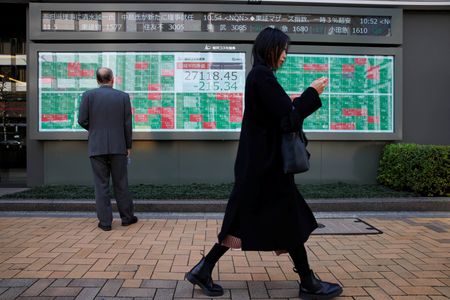


By Herbert Lash
NEW YORK (Reuters) -A gauge of global stock performance slid on Thursday after U.S. jobless claims and a modest rise in producer prices suggested a slowing economy, which also pushed Treasury yields lower as it could allow the Federal Reserve to stop raising interest rates.
The number of Americans filing new claims for unemployment benefits jumped to a 1-1/2-year high last week, while producer prices rebounded modestly in April, leading to the smallest annual increase in producer inflation in more than two years.
The two Labor Department reports suggested demand was slowing and raised the risks of a recession later this year as a credit crunch crimps bank lending.
“The inflation number and the jobless number confirmed each other a bit. Jobless claims were a bit higher and the PPI was a bit slower than expected. These are signs of a slowing economy,” said Peter Tuz, president of Chase Investment Counsel in Charlottesville, Virginia.
“People are expecting the Fed to start lowering rates sometime later this year. It looks like what they’re doing is working. The economy’s weakening and corporate earnings might be going not as higher as expected.”
Walt Disney Co slid 8.7% and was the second-biggest loser on the benchmark S&P 500 index, which fell 0.2%. Disney was the biggest loser in the Dow Jones Industrial Average, helping push it down 0.66%, while the Nasdaq Composite rose 0.18% on hopes of an imminent rate cut.
The better inflation outlook lowered Treasury yields on two-year notes, which can move in step with interest rate expectations, to 3.90% from above 4% before the Consumer Price Index data was released on Monday.
The yield on 10-year notes fell 5 basis points to 3.386%.
Futures showed the probability that the Fed will raise rates again in June was 10.7%, up from 2.1% soon after the data’s release, according to CME Group’s FedWatch Tool. The odds that the Fed cuts rates later this year also rose.
In Europe, the Bank of England’s 12th rate rise in row initially lifted Sterling almost half a cent against the dollar to top $1.26. The pound last traded at $1.2513, down 0.88% on the day.
Sterling touched a one-year high this week and was also seeing some profit-taking after the BoE rate decision.
“The wording in the statement (is) leaving more room to hike but absolutely no precommitment to do so,” said Orla Garvey, senior fixed income portfolio manager at Federated Hermes. “In this sense, as expected, we remain data dependent.”
The pan-European STOXX 600 index closed flat as falling energy stocks and Bayer’s worst one-day decline in almost two years offset early gains on hopes the Fed will ease monetary policy. Bayer fell 7.5%.
MSCI’s gauge of stocks across the globe shed 0.27%.
CONCERNS OVER WEAK DEMAND IN CHINA
In Asia, MSCI’s broadest index of Asia-Pacific shares outside Japan finished down 0.3%, reversing gains in the morning session, as concerns about weak demand in China weighed on sentiment.
China’s April consumer price data rose at a slower pace and missed expectations, while factory gate deflation deepened, suggesting more stimulus may be needed to boost a patchy post-COVID-19 economic recovery.
The consumer price index (CPI) in April rose 0.1% year-on-year, the lowest rate since February 2021, while the producer price index (PPI) fell at the fastest clip since May 2020, declining 3.6% year-on-year.
Markets were also watching the start of three days of Group of Seven (G7) finance leaders meetings in Japan that will seek to tease supply chains away from China – but also try to get its cooperation in solving global debt problems.
China’s blue-chip CSI300 index edged down 0.2%, along with Hong Kong’s Hang Seng.
In currency markets, the dollar index rose 0.65%. [FRX/]
“It’s a long-overdue correction, I don’t think there’s anything fundamental behind it with the debt ceiling unresolved. Stress is still on bank shares,” said Marc Chandler, chief market strategist at Bannockburn Global Forex in New York.
“The dollar can’t fall every day, I don’t see any fundamental hook behind the dollar’s bounce,” he said.
A sell-off in the South African rand and bonds gathered pace on Thursday, as news reports that South Africa had provided arms to Russia spooked investors already concerned about the economic impact of crippling power cuts.
The rand fell 1.78% to 19.1950.
Oil prices fell to a one-week low as a political standoff over the U.S. debt ceiling stoked recession jitters in the world’s biggest oil consumer, while rising American jobless claims and weak Chinese economic data also weighed.
U.S. crude futures fell $1.69 to settle at $70.87 a barrel, while Brent settled down $1.43 at $74.98.
Gold retreated as the safe-haven dollar advanced and outweighed support for bullion from lingering economic risks.
U.S. gold futures settled down 0.8% to $2,020.50 an ounce.
(Reporting by Herbert Lash, additional reporting by Marc Jones in London, Julie Zhu in Hong Kong; editing by Angus MacSwan, Sharon Singleton and Jonathan Oatis)

